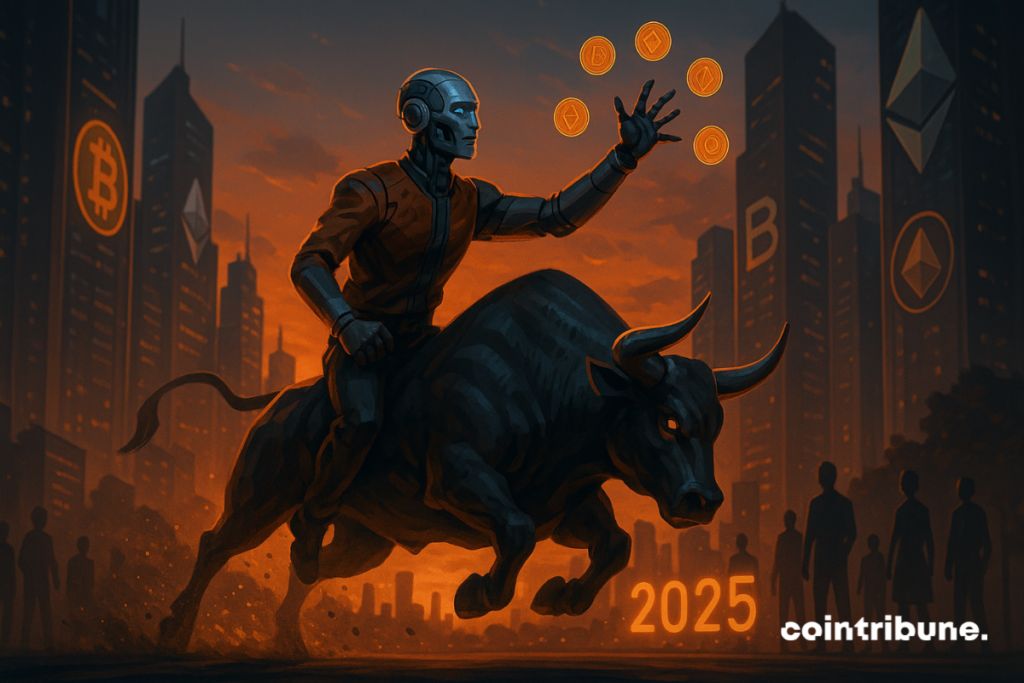Crypto AI 2025: 5 Promising Projects for the Bull Run
The demand for computing power, autonomous agents, and open markets for models is exploding, while centralized players (Big Tech & Clouds) concentrate the supply. The crypto market is trying to respond with decentralized architectures that reward the contribution of resources (GPU, models, data, security) and align incentives via a token.

In brief
- Five crypto-AI projects cover the entire value chain, from GPU to AGI.
- Robust infrastructure, proven utility and identified FOMO catalysts.
- Strategy: invest in stages and track adoption and execution metrics.
In this context, five projects stand out: Bittensor (TAO), Render (RNDR), Qubic (QUBIC), Fetch: ASI and Akash Network (AKT). The first four have already proven part of their robustness (liquidity, time‑to‑market, dev traction); the last brings an “AI-native L1” narrative that can create a strong catch-up effect.
Bittensor (TAO): The decentralized intelligence market
Bittensor turns AI into a tradable economic good: models compete, specialize, and are remunerated according to their utility measured by the network. It is, to date, the “pure AI” on-chain standard.
- Its advantages: a clear internal economy (rewards, penalties, specialization by subnets) and an already established brand.
- Its blind spot: governance and economic security of subnets, still evolving.
For a long-term investor, TAO remains the default bandwidth of the “AI marketplace” narrative.
Render (RNDR): GPU liquidity that has already proven itself
Render aggregates decentralized GPUs and rents them to creators (3D rendering) and increasingly, to AI workloads.
Its strength: a real adoption, an identifiable team/foundation, and deep liquidity. It is one of the few AI tokens to have gone through several cycles with readable utility.
In a world where computing power is the new raw material, RNDR ticks the box “already industrialized infrastructure.”
Qubic (QUBIC): The AI-native L1 that makes computing “useful”
Qubic takes a radical position: every watt spent by the network must serve something useful.
Its design combines useful-Proof-of-Work, quorum-based computation, and high-speed execution on a fixed set of nodes (“Computers”) validating by quorum.
A powerful L1: consensus finances AI compute, not the other way around. Technically, it is young, ambitious, potentially asymmetric in terms of yield if the AI application stack takes off.
FOMO here would come from a series of concrete deliveries (performant smart contracts, productive events, major listings, Monero mining, …) coupled with sound tokenomics and a halving in August that radically changes its speculative side.
Fetch.ai – ASI: Autonomous agents… boosted by the merge
Fetch.ai early pushed the thesis of autonomous agents (bots that trade, orchestrate, and make decisions in complex ecosystems).
With the announced convergence towards ASI (merge with other heavyweights of data and decentralized AI), the project tries to build a meta-asset capable of capturing value from multiple verticals at once.
- Strengths: marketing punch, liquidity, clarity for institutions.
- Watchpoint: execution of the merge and effective value capture by the single token.
Akash Network (AKT): The permissionless cloud for AI
Akash provides a decentralized cloud infrastructure where compute providers monetize their resources in a permissionless way, often at costs lower than hyperscalers.
AI is an obvious demand driver (inference, fine-tuning, mid-cap model training), and AKT plays the “AWS in open market” card.
Its robustness comes from a simple business model (compute supply vs demand), a clear roadmap, and a known security framework (Cosmos stack, repeated audits).
Risk: head-on competition from traditional clouds who lower their prices or launch pseudo-open “sub-markets”.
Buy, but without losing your head
The temptation to “buy everything before it takes off” will be strong if the double AI + altseason narrative restarts.
The right reflex is to stage your entries, size your positions, and follow simple and objective metrics: dev adoption, real volumes, TVL/token usage, number of processed workloads, industrial partnerships, and especially execution speed versus announced roadmaps.
Summary Table
| Project | Token | The goal it pursues | Why it seems “(relatively) secure” | Probable FOMO trigger |
| Bittensor | TAO | Decentralized market where AI models measure, specialize, and get paid | Proven traction, clear incentive model, strong niche AI reputation | New performing subnets + capital influx to “pure AI plays” |
| Render | RNDR | Rent decentralized GPU power for rendering and AI | Battle-tested track record, high liquidity, immediately understandable utility | Rebound in on-chain GPU demand and industrial deals |
| Fetch.ai – ASI | FET / ASI | Unify agents, models and data via a common post-merge token | Liquidity, support from major exchanges, convergence roadmap | Launch/success of ASI + large scale production agent use cases |
| Akash Network | AKT | Permissionless decentralized cloud for AI workloads | Proven Cosmos stack, readable supply/demand model, competitive costs | Sharp increase in “off Big Tech” AI compute demand |
| Qubic | QUBIC | “AI-native” L1: consensus based on useful computing (uPoW), quorum and execution | Security-oriented architecture (quorum), AI-focused design, expanding dev community | Performant smart contract + major listings + measurable utility proofs (TPS, workloads) + Monero mining |
Is AI a top narrative of the bull run?
Betting on a basket including Render, Akash, Bittensor, Fetch.ai now ASI, and Qubic means covering the entire value arc of the crypto-AI convergence: from hardware infrastructure previously locked by hyperscalers, to the full monetization of intelligent agents.
Render and Akash provide the foundation: the first turns surplus GPU power into liquid resource, while the second offers an open “super-cloud” where models can run and autoscale frictionlessly. Once this computing muscle is in place, Bittensor serves as a neural marketplace: researchers connect their networks, the best are rewarded, and the protocol continuously recycles these innovations into new subnets.
On this foundation, ASI plays the role of large-scale aggregator. By unifying data, inference, and liquidity, the merged token (ex-FET, AGIX, OCEAN) becomes the key to an ecosystem where access to data and models is seamless, whatever the underlying chain-stack.
Finally, Qubic closes the loop with a highly asymmetric proposition: turn mining energy into neural network training, then burn part of the reward to make the asset rarer over iterations, cumulatively train an AGI, many smart contracts, and surely one of the largest active crypto communities.
Disclaimer: The content of this article solely reflects the author's opinion and does not represent the platform in any capacity. This article is not intended to serve as a reference for making investment decisions.
You may also like
Crypto: Fundraising Explodes by +150% in One Year

Bitcoin Drops $8B In Open Interest : Capitulation Phase ?

Coinpedia Digest: This Week’s Crypto News Highlights | 29th November, 2025
